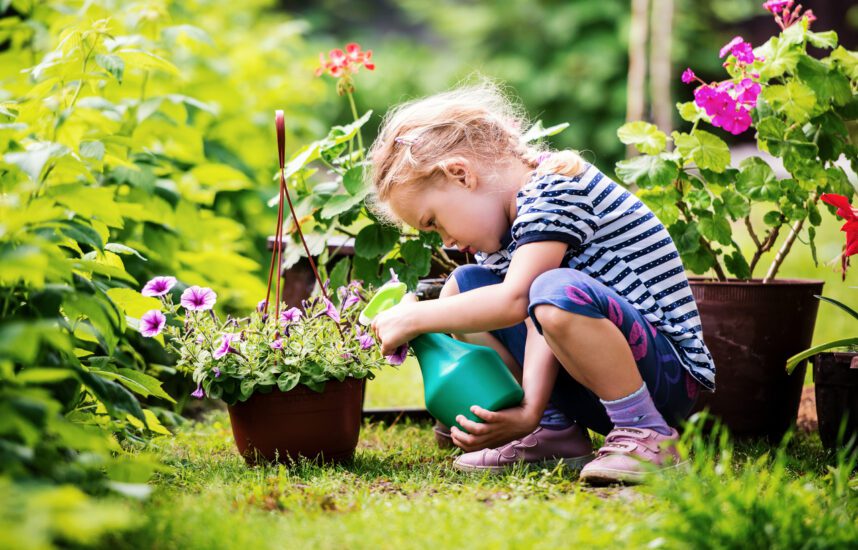Patience, like gardening, is a learned skill. The earlier we learn, the better chance we have to develop a lifelong ability to handle prolonged situations. Gardening is a wonderful way to teach children that good things come to those who wait.
Children learn a range of new skills from gardening, such as responsibility, love of nature, and self-confidence. Don’t forget about cooperation, nutrition, creativity, and various forms of physical activity.
Sparking Interest
Your kids may not like eating vegetables, but when they grow their own, maybe they’ll check out the fruits of their labor. Nothing tastes as good as when you grow it yourself!
- Give each child his or her own garden space.
- Provide lightweight tools and seed pots.
- Encourage the kids to dig in the dirt!
- Set up a worm farm. Those squirmy little things are fun to watch.
- Plant a rainbow of flowers, gourds, strawberries, tomatoes, peppers, beans, and whatever else looks good.
- Let your kids pick out colorful flowers to attract birds and butterflies.
Responsibility
Kids may look forward to the day they will be responsible enough to get their driver’s license. For parents, one step on that road is when they’re responsible enough to mow the lawn. Gardening and yard work are good ways to teach kids patience and responsibility – the physical activity is a bonus.
Start with a lesson on how to show respect for basic tools of the trade. Whether it’s a human-powered reel mower, a push-from-behind motorized model or even a riding version, kids must learn how the machine works and the dangers of moving blades. A proper “dress code” for mowing is to wear closed-toe shoes, long pants that don’t drag on the ground, and safety glasses.
Weeds vs. Plants
The art of patience begins with you, and your kids will notice when you get frustrated. Weeds are frustrating — they never completely go away. But even “real” plants can resemble weeds. If you don’t know the difference, you’ll be pulling the wrong ones out of the lawn and garden.
Weeds such as dandelion, oxalis, crabgrass, clover, nutsedge, and thistle are easy to spot, but some desirable plants’ leaves and stems resemble invasive weeds so you must learn which is which. This is also a great learning opportunity for your kids. Get a picture book that identifies various weeds, and praise them when they’re able to separate the weeds from the “good” plants.
Plant Selection
Adults are impatient enough. Kids? Even more so. Fast-growing plants such as corn, pumpkins, and sunflowers progress at a satisfying pace while still building patience. They develop quickly enough to keep piquing their curiosity.
Choose plants that appeal to all their senses.
- Smell: sweet peas, lavender, mint, lemongrass, and jasmine.
- Taste: carrots, cherry tomatoes, strawberries, peas, peppers and just about all fruits and veggies.
- Touch: aloe vera, cacti, woolly lamb’s ear, bottlebrush plants.
- Color: marigolds, daffodils, petunias, snapdragons, roses, and every other colorful veggie.
- Sound: high grasses rustle in the winds. They attract woodland creatures too!
Tips for Gardening with Kids
- Start with a diary for your children to keep track of plant growth on a daily or weekly basis. Seeing each plant grow and making note of its progress helps the kids learn to accept what is happening before them.
- Keep sprays and fertilizers out of reach! Use organic weed killers and fertilizers whenever possible, store tools in an easy-to-reach manner, and secure fences and gates.
- Shaded umbrellas, floppy hats, sunscreen, and insect repellent are tools of the trade.
We’ve all heard patience is a virtue, but some people get there sooner than others. For kids, the shortest wait can feel like an eternity. The best way to teach this art form is to paint the canvas yourself. The more patience you show with your kids, the more they’ll have for gardening and other tasks.
Clarence Luna is a freelance writer and former teacher who enjoys gardening and do-it-yourself projects. His current goal: grow tomato plants in his garden as tall as his 6-foot 5-inch frame.


